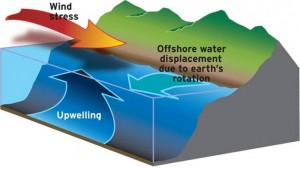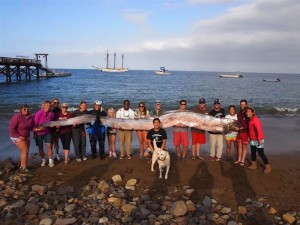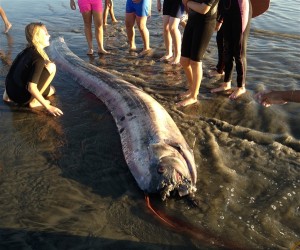Oarfish and Earthquake Myths
Last fall, there was a big buzz across the internet when two rare events happened just five days apart: the stranding of two dead oarfish on southern California beaches. On Oct. 13, an 18-footer was found on Catalina Island, and on Oct. 18, a 14-footer was found on the beach in Oceanside. The oarfish is an amazing-looking sea creature, with a long, flat, serpentine body, a long dorsal fin along the entire length of its body, and tiny spine-like pectoral and pelvic fins. It is thought to have been the source of some of the “sea serpent” legends, since large specimens can be up to 50 feet (15 m) long. The fact that two such strandings had happened so closely in time generated most of the buzz, since strandings are normally rare, with one or two a year at most. Once in awhile there are accidental sightings of oarfish which are apparently trying to beach themselves, such as shown in this remarkable footage.
The biggest buzz, however, was not about the unusual occurrence of two strandings in five days, but about some Japanese legend that claims that oarfish strandings predict earthquakes. This ridiculous idea managed to get coverage on a wide variety of news sites and websites, including the BBC, with almost no mention of any scientist debunking it. As usual, the credulous media ran with the story for days and not once did you hear the slightest bit of skepticism (except maybe a passing sentence or two from some biologist or geologist).
For the record, the entire story is based on a Japanese legend, with absolutely no basis in fact. As reported on one website:
According to traditional Japanese lore, oarfish rise to the water’s surface and beach themselves to warn of an impending earthquake, a notion that some scientists have speculated could be supported by the bottom-dwelling fish being more sensitive to seismic shifts. Known as the “Messenger from the Sea God’s Palace,” over a dozen “ryugu no tsukai,” or slender oarfish, either washed ashore or were caught in fishing nets in the Ishikawa, Toyama, Kyoto, Shimane and Nagasaki prefectures near the quake’s epicenter months before the 2011 quake hit, according to several reports.
But as Sharon Hill points out, several months before the 2011 quake is not really much use in predicting it for anyone’s planning purpose. Because both Japan and California experience almost constant small earthquakes each month, and several moderate quakes a year, it is basically a prediction with no real testability. At best, it’s an example of a correlation that has no real causation link.
This urban myth falls within the general legend of the many types of “strange animal behavior” that allegedly occurs before quakes. As many people have documented, there is no conclusive evidence that such strange behavior actually predicts quakes in any useful way. More often that not, animals demonstrate “strange behaviors” many times in a month, but only when we notice that an earthquake occurred right afterwards do we make the false correlation that the two are related. The only plausible mechanism for animals to react ahead of a real quake is if they are more sensitive to the first-arriving P-waves than humans are, while we fail to notice the P-waves and only notice the quake when the more damaging S-waves and surface waves arrive seconds later. But at best, this gives you only a minute or two warning, not enough to do some serious preparations or evacuations. Besides, the Japanese already have this built into their quake warning systems, so the people far from the Sendai quake in 2011 (for example, in Tokyo) did get a few seconds warning, and were braced when the shock waves arrived. The people close to the epicenter, however, got no such benefit.
Sadly, what was completely ignored by the media was the real story about the oarfish strandings: are they just a random accident, or is there some scientifically plausible cause? Oarfish are slow-swimming plankton feeders (feeding mostly on small crustaceans) that slowly cruise the oceans at depths up to 1000 m (3300 feet) in all the oceans of the world. They only rarely come near the surface, but are known to do so if they are sick, which probably accounts for the majority of strandings. However, neither of the recent California oarfish who beached were apparently sick, although one was gravid with fertilized eggs. A more likely explanation is provided by oceanographers such as Kim Martini. She points out that during the stranding period, we experienced a strong southeast-trending coast-parallel set of winds that forced the nearshore waters seaward (due to the Corolis force), which then causes deep waters to upwell to the surface to replace them, bringing deep nutrients and causing big explosions of plankton and fish and whale populations. This is common along many coasts where there are big fisheries, but it was unusually strong last October. As Martini points out:

Upwelling occurs when a strong coast-parallel wind forces the shallow waters offshore (due to Coriolis forces), causing deep waters to rise to replace the shallow water
But upwelling may not be so kind to the Oarfish. Oarfish are pelagic fish, meaning they like deep water. So conceivably, upwelling currents could possibly drag unsuspecting Oarfish up the slope and onto the beach. While Oarfish in the wild have been observed to be very chill swimmers, this is probably highly unlikely. Upwelling currents really aren’t strong enough to push them onshore. … A more likely scenario is that Oarfish were “tricked” by the upwelling currents to head closer to shore and shallower water when they normally wouldn’t. The bathymetry around Oceanside and Catalina island is complicated and there are many deep canyons that Oarfish could conceivably inhabit. When upwelling pushed the deep water that Oarfish typically like to hang out in up and onto the slope, they might have just tagged along, following environmental cues like temperature, salinity or even food abundance. Why they aren’t tricked onshore during the typical upwelling season is beyond me, but it might have something to do with their population distribution. Oarfish just might not be near the coast during the spring upwelling season.
It’s an interesting idea consistent with the known scientific facts, and certainly testable, although I don’t know if anyone has pursued it in detail yet. It’s a lot better than the garbled Japanese myths that the media played endlessly, instead of seeking a plausible scientific solution.



Hadn’t heard the oarfish story before, but I do get tired of the periodic stories (always after the fact) of people’s pets “predicting” a quake hours in advance.
Yes, the stories about pets sleeping through earthquakes don’t seem to make it onto the Internet very often :-).
I don’t know, there have been several oarfish sightings around Oklahoma City this month.
Look, I appreciate what you’re trying to do, but delving too deep into the absence of correlations between dead fish and earthquakes just makes you look like a popinjay. Of course dead fish don’t predict earthquakes and any sensible person can see that. And those few who cannot are beyond help and will certainly not be talked out of it by talk of corelayshunts.
Like it or not, some things are just too stupid to take seriously. And if you do take them seriously, seriously enough to write an article about them at that, people will rightfully ask pointed questions about the contents of your head, regardless of what you actually write about them.
Apparently, you completely missed the point of the post. Sure, the “oarfish predict earthquakes” is silly. My point was that 1) it’s interesting to delve into the REAL scientific reasons for oarfish strandings; and 2) the media wasted everyone’s time by dwelling on a silly Japanese myth, and never did any coverage of the interesting science.
How can you possibly read back your own article and my post and come to the conclusion that I missed the point? I thought skeptics were supposed to be honest people?